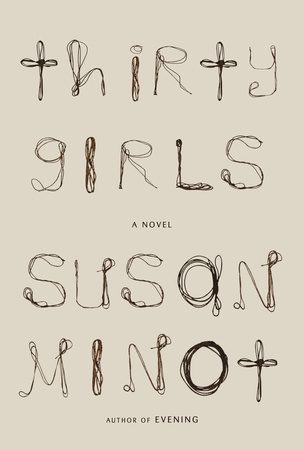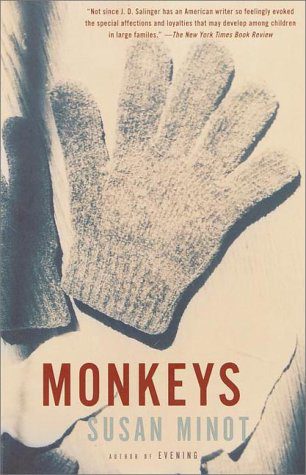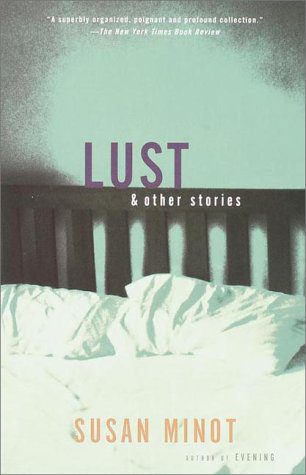
Susan Minot’s first book, Monkeys, was published in 1986, and she produced another book every three to five years like clockwork. That is, until, the dozen-year gap between her last one, Rapture and her current, Thirty Girls—the same twelve years since her daughter was born. Minot says her daughter tells her, “Don’t blame me, Mom!” She doesn’t blame her, but it sometimes helps explain. Her current novel takes place primarily in Uganda but also up and down sub-Saharan Africa. It tracks one of a group of thirty girls kidnapped by Joseph Kony’s Lord’s Resistance Army and Jane, an American journalist searching for meaning and struggling to find something real to latch onto. Though it may seem dated—Kony was a ghost long before that “Kony 2012” video went viral—the fate of kidnapped African girls has, depressingly, cycled back into the news with the rise of Boko Haram. It is, as is all of Minot’s writing, intensely empathetic and full of finely observed detail that brings us unsettlingly into the minds and situations of both protagonists.
When I get to Minot’s apartment, her daughter is home sick. Minot’s daughter sits on the couch watching something on her iPad while Minot makes her a snack in the kitchen. Her place is sort of like your crunchy-granola aunt’s—all muted multi-color draperies and a kitchen crowded with loved-looking pots and pans—but a really nice version of that. It reminds me, in many ways, of Topanga Canyon, that upper-class hippy stronghold between Malibu and Santa Monica. Minot has a picture of David Foster Wallace taped to her wall, an author photo that looks clipped from a magazine. This is confusing until I remember that Minot was name-checked in Wallace’s essay “Fictional Futures and the Conspicuously Young.”
***
The Rumpus: Did you teach at Columbia? Or do an MFA there?
Susan Minot: I went there—undergrad. I did those two years, too. When I went, it was maybe four years after I graduated from college. Three. When I graduated from college I thought, “I’m never going back to school.” But one thing led to another and I thought, “I’ll just try it.” I was there one semester; all I was doing was workshops, little seminars. It was like a banquet. I was working on my own writing a lot. It helped me get some perspective on it. I was ready for feedback. I was ready to try to make it better. And to try to be able to steep myself in literature. Teachers would mention something and I would go out and find it. It was good, intensive… I was waiting tables on the side. I had worked at the New York Review of Books before that but just as an assistant to Barbara Epstein. The thing about Columbia, is a lot of people who showed up there hadn’t been to New York and didn’t know what was going on.
 Rumpus: So you did your full two years there?
Rumpus: So you did your full two years there?
Minot: I went and I thought, “This is really good.” So I stayed the whole time. I applied for a scholarship and I got a scholarship for the second year. Are you from here?
Rumpus: I’m from Los Angeles. I just came out here for school. So let’s talk about the book. Thirty Girls. I knew absolutely nothing about it when I started reading it.
Minot: That’s good.
Rumpus: I had no idea it was going to be about Joseph Kony.
Minot: Except it’s not. It’s about his world.
Rumpus: He’s the evil, central figure.
Minot: Right, the world around Joseph Kony. But you had heard of him.
Rumpus: Yeah, when the whole Kony 2012 thing happened.
Minot: That was two years ago. Joseph Kony’s been around since the mid-90s.
Rumpus: That’s when I first heard about him. You were working on this book before that.
Minot: Let’s see. If I finished in 2013, I started in 2005.
Rumpus: What was it like when that was coming out? You had been working on the book for seven years.
Minot: Interestingly enough, it’s still not even famous for people discovering Kony, it’s famous for being the video that went most viral ever. And then the guy who made it went running naked through the street and is really what people talk about now. I think he had a psychic break because he had all this criticism. Safe to say, he was not expecting the kind of attention he got. The video he made was a little simplistic.
Rumpus: It was a viral video.
Minot: Yeah. To his credit, the simplicity and the sensational way he made it is what made people watch it. Bottom line, people heard about Joseph Kony who hadn’t. That’s the good news about it. The bad news is, it wasn’t really conveying what was going on. The real situation was a little more complicated. The video gave this impression that sixty thousand people were captured somewhere which isn’t the story.
Rumpus: It’s much more fractured than that.
Minot: Very fractured. And tens of thousands of children have been affected but they come and they go. Some children are kidnapped twice.
Rumpus: How did you come to this topic?
Minot: I did write a story—I’ll answer it a little bit but instead of wasting your time—in Vogue. They dressed me up a little, but I wrote an essay about where the idea for the book came from. If you want to pick up your Vogue, it’s on the stands right now. That answers all those questions. Short version: I went to do a story about these children because I met the mother of one of them at a human rights thing in New York. Grace, the mother, Grace Dolo. Very similar to Jane, the main character.
Rumpus: Does Jane’s trip mirror yours in any way?
Minot: I’ll answer that to the side by saying I’ve written a novel, so I’m not trying to—
Rumpus: I’m not accusing you of writing an autobiography.
Minot: No, no, no. The question is: Is this based on this? And I think that’s important to answer where there is a true story. The story of the girls being kidnapped is very much based on a true story. I did a fictional version of it so we could experience it a little more. I think that’s what happens in fiction as opposed to—not that you can’t experience in journalism—but journalism is restricted by making sure that everything is true. You might not have access to the details, so you can’t use the details that make it come alive in another way. In that way, I say it’s absolutely based on a true thing. The choice of what the book is about and why it’s structured have reasons to do with the book, not what was going on in my life, if you follow me. So Jane is a character in the book because I didn’t want Esther’s story… Initially when I was writing the book, it was only going to be Esther’s story, and I found both in the writing of it, it was very hard to be only in the world for so long. I thought, “A reader’s going to find that hard, too.” This story, which I want to be heard… you don’t want to torture someone if you’re trying to tell them something that’s a little torturous. Jane was a way to have another thing going on, something a little… I don’t want to say lighter, but the love affair and these wild characters and being in a foreign place and all that experience, which is also an experience you have in the world. It sets up this sort of comparison, which at first makes you uncomfortable, I think. Which is kind of the point.
Rumpus: Definitely.
Minot: If it’s staying uncomfortable the whole time, then I haven’t made the point. But if by the end you realize, “Ok, this is her life and this the other person’s life and they sort of have things in common. But doesn’t it make this kind of suffering so much more profound compared to this?” And yet, by comparing it, it doesn’t particularly help you if you’re not in that intense thing. It’s hopefully a reminder—no one needs to be convinced that being in a war and being raped and having to kill people are higher, more moral stakes, and is more dramatic. No one needs to be convinced of that. What people need to be reminded of is, even if you’re not in that experience, you can’t dismiss your own struggle. Even if it’s a privileged one, that’s the one you have. If you think, “Oh, this is a stupid struggle I have because people have it worse.” Where does that leave you?
Rumpus: You can’t walk around like that.
Minot: I see that with some of my students. If I’m encouraging them towards exploring something a little more directly from them, they’ll say, “These aren’t important issues.” They’re aware of the imbalance of privilege, which is certainly a good thing to be aware of. But not to the point where you cancel out your own experiences. Like, “Oh, well I’m not starving, so what am I worrying about?” You’re worrying because you’re struggling.
Rumpus: Almost all of the canon is about affairs or rich people struggles. Most of Jane Austen’s—and I’m mischaracterizing here—work is about, “Oh my god, he’s not as rich as I thought he was.”
Minot: It’s about people trying to connect. That’s what it’s all about. Certainly where there’s a more evil situation—evil being something going against the laws of nature—which is to prey on people for no good reason except because you’re a nut—then you’re dealing with different things.
Rumpus: Couple things arising out of that response: Do you feel like because you’re dealing with this from a fictional perspective, you have more freedom with the details or more freedom to write as though from direct experience, do you feel that you’re getting at a larger truth than you could as a journalist? Like a human truth as opposed to, “This is what we can prove, this is what definitely happened.”
Minot: I think nonfiction can say just as profound things about human nature as fiction. No question. I wrote a story about these children sixteen years ago. Just on a practical level, I never heard a peep about it. Maybe except for a couple of friends, who said they read it, but that was it. That bothered me because of this particular subject. I definitely still had the feeling that I wanted this story to be heard. I’m a fiction writer. I’m not a journalist at all. I’ve written non-fiction, it’s usually travel stories, so I thought, “Maybe I can go into this material and offer it back in a story doing something that I’m used to doing.” It was really: I’m a better blacksmith than I am a sculptor. [laughs] I know maybe I can get at the same issues… And it was just an article so it wasn’t as deeply imagined and worked out. And, you say to a larger concern, absolutely this book is not about what happened or what was going on with Joseph Kony. Ideally, the thing I’m addressing is violence and trauma and children and how they cope.
Rumpus: Those first hundred pages, the book opens with that kidnapping scene, which is action packed and engaging… And then we step into Jane’s perspective and my thought was, “Oh my god, what happened to the kids?!” That was obviously very deliberate on your part, to have us stay with this Western journalist as she goes deeper and deeper into a very messed up place. What was that decision like to have that be such a lengthy section, to delay returning to Esther’s perspective for so long?
Minot: I think we get back to Esther before 100 pages. Esther comes in on page 39. Only for a minute, you don’t quite know. She’s in the rehabilitation.
Rumpus: That’s what it is, you don’t get back to the kidnapping for quite a while.
Minot: That’s right. We don’t… There was one version where the story of the kidnapping started on page sixty. We started out with Jane, this woman on a trip. And then you meet Esther and, “Who’s this girl?” And then you see what happened. It seemed more straightforward to start off with the organizing.
Rumpus: In a way, although that encounter between the two of them comes back in Esther’s section. It’s strange that that sort of non-linear storytelling ends up being simpler.
 Minot: I also, with Esther, originally had her with the children—still with the rebels. She wasn’t in the rehabilitation center. I wasn’t sure if Jane was necessarily going to meet her. This is all seven years’ worth. So you switch it. At one point I was going to follow three of the thirty girls. It was going to be Esther, Louise, and Janet, and I was going to tell their stories as a way of examining how trauma affected them in different ways. And it does. You keep making choices as you go on. With Esther, I realized I wanted her to be in a peaceful place. I just wanted her to get out of there.
Minot: I also, with Esther, originally had her with the children—still with the rebels. She wasn’t in the rehabilitation center. I wasn’t sure if Jane was necessarily going to meet her. This is all seven years’ worth. So you switch it. At one point I was going to follow three of the thirty girls. It was going to be Esther, Louise, and Janet, and I was going to tell their stories as a way of examining how trauma affected them in different ways. And it does. You keep making choices as you go on. With Esther, I realized I wanted her to be in a peaceful place. I just wanted her to get out of there.
Rumpus: You just wanted something good happen.
Minot: Literally! While I’m with her for seven years. I didn’t know it was going to take seven years but I wanted to feel that she was at least… It’s not happening to her now. Which, while I was writing the book, it was still happening to these girls.
Rumpus: And it still is, right?
Minot: No, it’s not. Kony left Uganda in 2009, I think. And he was still raiding. In the last two years, he’s been pretty much out of sight. Nobody really knows where he is. Obama, after the “Kony 2012” video, sent some Green Berets in to look for him when he was in Congo. Now they think he’s in the Central African Republic. Rumors are that he’s sick, which is a good thing. But he doesn’t have… At his largest moment he counted 2,000, he called them, family members.
Rumpus: And those were children?
Minot: Probably 1,200 of them were children. Were abducted children, I should say. Some of them were there for ten years, so they were abducted at 14 and then they’re 24.
Rumpus: And people born into captivity.
Minot: I don’t think that that was such a large part, because if it went on sixteen, seventeen years, there wouldn’t be a lot of—but there certainly were those too.
Rumpus: Maps and territory play a large part in this novel. We travel with Jane and there’s a scene in which the girls are sort of auctioned off to Kony’s soldiers. And they’re standing on a map of Uganda. Harry’s face is described as a map. Is that something you consciously wrote into? Was there an a-ha moment of, “I’ve got a million maps in here, I need to push those!”?
Minot: No, I didn’t actually think of it that way. I was conscious of the first thing that Esther and Jane have in common with each other is geography. That was an important concept to stick with. It was one of the reasons that Jane was created. There needed to be… Not needed to be. For someone to be having an extremely different experience fifteen miles away…. We’re spatial creatures. Here, Uganda is across an ocean. What’s going on over there? They cut people’s lips off? If you’re nearby where that’s going on, you’re thinking, “I’m close to something here.” For Jane, the geography is very much about this new place and how inspiring it was. And for Esther it was something she had to measure to see how far she had to go to get away. And where were they? They were lost and they didn’t know where they were.
Rumpus: They’re constantly revisiting places, or they think that they are, but they’re not sure. They don’t walk in a straight line.
Minot: Yeah, and also there are paths around and it’s not mapped. All of that was important. No one’s ever pointed out the map of Harry’s face.
Rumpus: That is in there; I’m not hallucinating.
Minot: Yeah, yes! And Esther, she says that when Grace comes to see her— Louise’s mom—she says, “She looks at me like a map, where she can find the treasure that is hidden.”
Rumpus: It’s interesting that the relative size of their worlds is so different.
Minot: That as well.
Rumpus: Jane’s experiential world—most of it’s moving from estate to estate to estate and being waited on by servants and, like, “Does this twenty-two-year-old like me?” Whereas Esther’s world is this incredible trauma.
Minot: Very human, high stakes interaction. And having to have a baby, having to escape, not knowing if she’s going to live or die every day.
Rumpus: Although thankfully we do. That’s very nice of you to put that early on. But then they come together, and it’s very powerful to see those two worlds interacting. What was it like to write that? How many drafts did you go through? What was it like getting that exactly right?
Minot: It used to be a lot longer. Because it was important. I had to figure out… because we’ve been with Jane third-person and we’ve been with Esther first-person. I wasn’t sure… They’re together in the same section, so it goes back and forth from gap to gap. So that was something I had to work out. At first, I had each of the whole versions of the meeting. Of that day.
Rumpus: And it was just too much?
Minot: Yeah. Or, it was two separate ones. Then it was back and forth and I still switched them. And then I realized it was overdoing it. I settled on switching back and forth and they tell their own version of it.
Rumpus: It really was a focusing down, cutting away.
Minot: Mhm. I had much more of what Esther said and then at one point, I switched it to: “I told her the story I told to you,” at one point rather than, “I’m going to reiterate some of these stories.” So I had many different versions of her telling different stories. There’s the version that we already had in the book—as if it’s her internal telling—but I had her spoken version of that.
Rumpus: But you just…
Minot: I have a visual for you, because you’re here at the apartment. [Minot pulls out a huge file box]. This is the first book I wrote on a computer. I mean, put it for the third draft on a computer. I write with these [smallish cards] first. And then I put it on a manual typewriter. The last book I handed in on a manual typewriter, it was a typewritten thing, but I figured, “Ok, someone else is gonna put this on a disc.” So. This is like one of my notebooks. By the time this is typed, things are way—
Rumpus: Do you have a count of how many pages you’ve written?
Minot: No! Each section is like this.
 Rumpus: Were there any massive, one-shot cuts where you would lose hundreds of—?
Rumpus: Were there any massive, one-shot cuts where you would lose hundreds of—?
Minot: Yeah. That would happen at the end. And you think, “Why the hell did I spend a month writing this?” It’s only in the winnowing that you start to realize the pacing of it and then you start saying… My brother-in-law had a very good description of when you’re cleaning a room. You have to clean everything out—maybe it’s your office and you’re moving—you start very carefully going through things. Maybe for the first few hours. By the end of the day, you’re looking at a box and then you chuck the whole thing out. You’re near the end and you… The manuscript was probably a quarter longer than a book.
Rumpus: I’m always interested in the large throwing-away.
Minot: What I usually do, I’m not going to save this, but I might save some of the Jane sections because I like to write about women struggling and many of her thoughts I could save for some other struggling woman.
Rumpus: Nothing is wasted, right?
Minot: A lot of the children’s stories… I could use some slightly different version, but I don’t think I’m going to. That was very, very particular to Uganda.
Rumpus: There’s that moment of—spoiler alert—violence that comes into Jane’s world when Harry gets shot. And it—very briefly because it’s right near the end—becomes a different book. Did you know that moment was coming the entire novel? Was it something you were consciously building towards?
Minot: Well, I wasn’t building towards it, was I? Because it was a surprise [laughs]. But did I know it was there? I would say, if we’re talking about the seven years? Because Jane wasn’t really a thing and then Harry… Pretty much on the early side, certainly more than halfway through the writing I knew that it would happen. Well, actually, it was going to be something different happening. It was going to happen while they were in Uganda. And there was gonna be—I wrote that, I never used it—a roadblock-type situation with the Ugandan army stopping people. They did have a sprinkling of army people who were supposedly tracking [Kony’s] LRA but it was a lame effort on the part of the president. He wasn’t particularly concerned about the north. It was not one of his tribe. And it was going to be an army thing and it was going to be a drunken guy and Harry was going to be seeing them messing with a boy and he tries to intervene. And he gets shot.
Rumpus: So it was much more heroic originally.
Minot: Yeah. It was sort of heroic, it was sort of also… they don’t—
Rumpus: They don’t care that it’s Harry.
Minot: Yeah. It was some drunken jerk. It was in Uganda. Where things were dangerous. But it wasn’t the LRA. I thought, no, it has to be on their own turf and it has to be just—not that in Nairobi violence is unheard of by any means—but it just comes—
Rumpus: From the clear blue sky.
Minot: Yeah.




